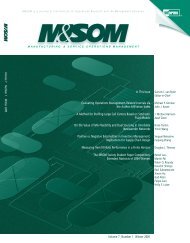Strengthening the Empirical Base of Operations Management
Strengthening the Empirical Base of Operations Management
Strengthening the Empirical Base of Operations Management
You also want an ePaper? Increase the reach of your titles
YUMPU automatically turns print PDFs into web optimized ePapers that Google loves.
Fisher: <strong>Streng<strong>the</strong>ning</strong> <strong>the</strong> <strong>Empirical</strong> <strong>Base</strong> <strong>of</strong> <strong>Operations</strong> <strong>Management</strong><br />
372 Manufacturing & Service <strong>Operations</strong> <strong>Management</strong> 9(4), pp. 368–382, © 2007 INFORMS<br />
<strong>of</strong> <strong>the</strong> many nuances <strong>of</strong> vehicle routing that arise in<br />
practice, a taxonomy <strong>of</strong> <strong>the</strong> various versions <strong>of</strong> real<br />
vehicle routing problems, and a knowledge <strong>of</strong> vehiclerouting<br />
data structures. For example, Fisher (1994)<br />
observes that <strong>the</strong> delivery points in real vehiclerouting<br />
problems are highly clustered and discusses<br />
how to exploit this in an optimization algorithm. If<br />
<strong>the</strong> essence <strong>of</strong> empirical research is ga<strong>the</strong>ring and<br />
understanding information about <strong>the</strong> world, all <strong>of</strong> this<br />
clearly constitutes significant empirical research.<br />
Bowman (1963) presents an excellent example <strong>of</strong><br />
learning through implementation. The paper was<br />
already a classic by <strong>the</strong> late 1960s when I was a graduate<br />
student, and it pr<strong>of</strong>oundly influenced me and<br />
many o<strong>the</strong>rstudents at that time. Holt et al. (1955)<br />
describe decision rules to determine optimal monthly<br />
production, inventory, and workforce levels as linearfunctions<br />
<strong>of</strong> priorvalues <strong>of</strong> <strong>the</strong>se variables and a<br />
demand forecast. Bowman (1983) applied <strong>the</strong>se rules<br />
to ice cream, chocolate, and candy plants in three separate<br />
studies. He first used accounting data to derive<br />
accurate estimates <strong>of</strong> <strong>the</strong> coefficients required in <strong>the</strong><br />
decision rules and obtained results that improved on<br />
existing practice. But, surprisingly, he got still better<br />
results by choosing <strong>the</strong>se coefficients so <strong>the</strong> output <strong>of</strong><br />
<strong>the</strong> decision rules most closely matched, on average,<br />
managers’ past decisions. Amazingly, rules fitted to<br />
managers’ prior decisions did better than <strong>the</strong> managers<br />
<strong>the</strong>mselves!<br />
Bowman’s findings illustrate that one <strong>of</strong>ten makes<br />
interesting discoveries in <strong>the</strong> process <strong>of</strong> implementing<br />
an algorithm. Bowman’s discovery was a principle<br />
that he summarized as follows. Managers make<br />
good decisions on average, but <strong>the</strong>y are hurt by variation<br />
in <strong>the</strong>irdecision making. Thus, “A decision rule<br />
with mean coefficients estimated from management’s<br />
behaviorshould be betterthan actual performance [<strong>of</strong><br />
<strong>the</strong> managers]. It may also be better than a rule with<br />
coefficients supplied by traditional analysis” (p. 321).<br />
3. <strong>Operations</strong> <strong>Management</strong><br />
Econometrics<br />
Many fields apply regression and o<strong>the</strong>r statistical<br />
analysis tools to data sets in an attempt to discover<br />
evidence to support various hypo<strong>the</strong>ses. In fact, this<br />
is <strong>the</strong> type <strong>of</strong> research that most people in our field<br />
associate with <strong>the</strong> term empirical research.<br />
Without question, <strong>the</strong> International Motor Vehicle<br />
Program study <strong>of</strong> 70 automobile assembly plants<br />
worldwide is <strong>the</strong> “mo<strong>the</strong>r” <strong>of</strong> all operations management<br />
econometrics research efforts. This ambitious<br />
study, which began at MIT. in <strong>the</strong> late 1980s and<br />
continues to this day, seeks to discoverand validate<br />
management practices associated with high levels <strong>of</strong><br />
quality and productivity in an automobile assembly<br />
plant. The average number<strong>of</strong> defects pervehicle as<br />
measured by <strong>the</strong> J. D. Powers survey that tests most<br />
car models is used as <strong>the</strong> measure <strong>of</strong> quality. Productivity<br />
is equated to <strong>the</strong> number<strong>of</strong> hours to assemble<br />
a vehicle, a metric tracked by most automobile<br />
plants. To compare two different plants, this metric<br />
is adjusted to normalize for differences in vehicle<br />
complexity.<br />
The study 2 found large differences in quality and<br />
productivity between plants. Moreover, those plants<br />
with <strong>the</strong> highest productivity also tended to have <strong>the</strong><br />
highest quality, contradicting <strong>the</strong> conventional wisdom<br />
that productivity and quality trade <strong>of</strong>f against<br />
each o<strong>the</strong>r. High performance was correlated with<br />
certain practices that have come to be called “lean<br />
production” and include just-in-time inventory management<br />
and a high degree <strong>of</strong> worker involvement.<br />
Although <strong>the</strong>se practices are typically associated with<br />
Japanese manufacturers, it was shown that this is<br />
not merely a Japanese effect; <strong>the</strong>re were a significant<br />
number <strong>of</strong> poorly performing plants within Japan<br />
that did not follow lean production principles and<br />
an equally significant number<strong>of</strong> highly performing<br />
plants outside <strong>of</strong> Japan that did follow lean production<br />
principles.<br />
The automobile industry has proven to be a fertile<br />
context for<strong>the</strong> application <strong>of</strong> econometric methods.<br />
Ano<strong>the</strong>rhighly successful example is Clark and<br />
Fujimoto (1991), which reports results <strong>of</strong> an extensive<br />
study <strong>of</strong> product development in <strong>the</strong> auto industry.<br />
The authors examined a large number <strong>of</strong> new model<br />
development projects at 20 automobile manufacturers<br />
worldwide to understand <strong>the</strong> management practices<br />
that influenced design quality, product development<br />
time, and product development productivity as measured<br />
by <strong>the</strong> engineering hours required by a project.<br />
2 The results <strong>of</strong> this ongoing study have been published in many<br />
papers. Early work can be found in Krafcik (1988) and MacDuffie<br />
(1991), with more recent results in MacDuffie et al. (1996).




